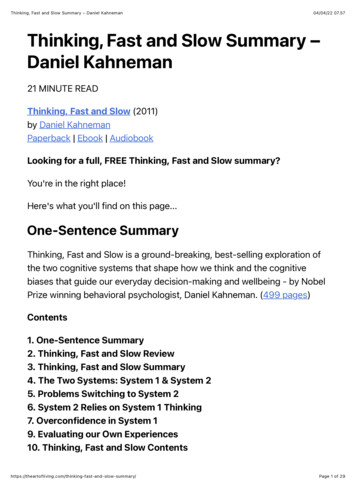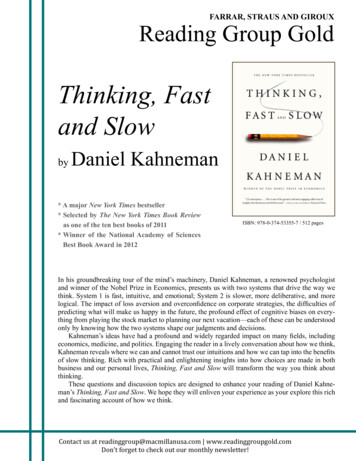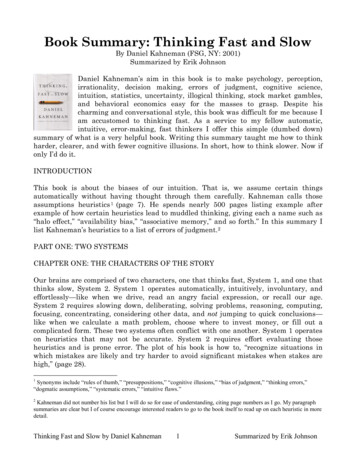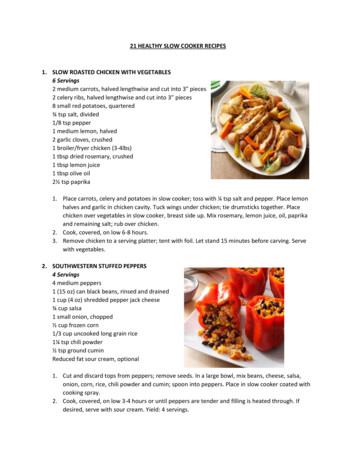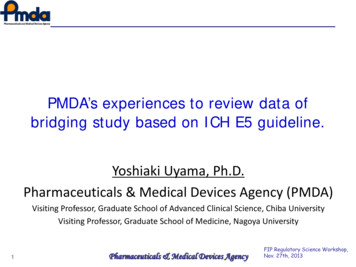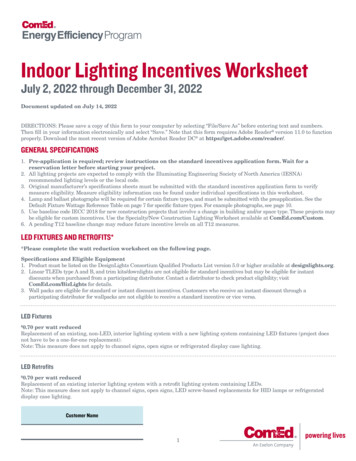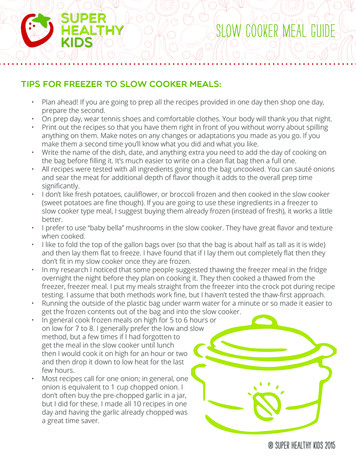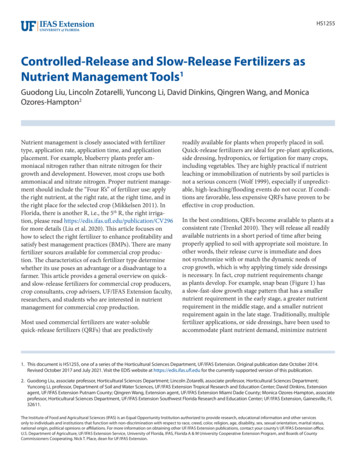
Transcription
HS1255Controlled-Release and Slow-Release Fertilizers asNutrient Management Tools1Guodong Liu, Lincoln Zotarelli, Yuncong Li, David Dinkins, Qingren Wang, and MonicaOzores-Hampton2Nutrient management is closely associated with fertilizertype, application rate, application time, and applicationplacement. For example, blueberry plants prefer ammoniacal nitrogen rather than nitrate nitrogen for theirgrowth and development. However, most crops use bothammoniacal and nitrate nitrogen. Proper nutrient management should include the “Four R’s” of fertilizer use: applythe right nutrient, at the right rate, at the right time, and inthe right place for the selected crop (Mikkelsen 2011). InFlorida, there is another R, i.e., the 5th R, the right irrigation, please read https://edis.ifas.ufl.edu/publication/CV296for more details (Liu et al. 2020). This article focuses onhow to select the right fertilizer to enhance profitability andsatisfy best management practices (BMPs). There are manyfertilizer sources available for commercial crop production. The characteristics of each fertilizer type determinewhether its use poses an advantage or a disadvantage to afarmer. This article provides a general overview on quickand slow-release fertilizers for commercial crop producers,crop consultants, crop advisers, UF/IFAS Extension faculty,researchers, and students who are interested in nutrientmanagement for commercial crop production.Most used commercial fertilizers are water-solublequick-release fertilizers (QRFs) that are predictivelyreadily available for plants when properly placed in soil.Quick-release fertilizers are ideal for pre-plant applications,side dressing, hydroponics, or fertigation for many crops,including vegetables. They are highly practical if nutrientleaching or immobilization of nutrients by soil particles isnot a serious concern (Wolf 1999), especially if unpredictable, high-leaching/flooding events do not occur. If conditions are favorable, less expensive QRFs have proven to beeffective in crop production.In the best conditions, QRFs become available to plants at aconsistent rate (Trenkel 2010). They will release all readilyavailable nutrients in a short period of time after beingproperly applied to soil with appropriate soil moisture. Inother words, their release curve is immediate and doesnot synchronize with or match the dynamic needs ofcrop growth, which is why applying timely side dressingsis necessary. In fact, crop nutrient requirements changeas plants develop. For example, snap bean (Figure 1) hasa slow-fast-slow growth stage pattern that has a smallernutrient requirement in the early stage, a greater nutrientrequirement in the middle stage, and a smaller nutrientrequirement again in the late stage. Traditionally, multiplefertilizer applications, or side dressings, have been used toaccommodate plant nutrient demand, minimize nutrient1. This document is HS1255, one of a series of the Horticultural Sciences Department, UF/IFAS Extension. Original publication date October 2014.Revised October 2017 and July 2021. Visit the EDIS website at https://edis.ifas.ufl.edu for the currently supported version of this publication.2. Guodong Liu, associate professor, Horticultural Sciences Department; Lincoln Zotarelli, associate professor, Horticultural Sciences Department;Yuncong Li, professor, Department of Soil and Water Sciences, UF/IFAS Extension Tropical Research and Education Center; David Dinkins, Extensionagent, UF/IFAS Extension Putnam County; Qingren Wang, Extension agent, UF/IFAS Extension Miami Dade County; Monica Ozores-Hampton, associateprofessor, Horticultural Sciences Department, UF/IFAS Extension Southwest Florida Research and Education Center; UF/IFAS Extension, Gainesville, FL32611.The Institute of Food and Agricultural Sciences (IFAS) is an Equal Opportunity Institution authorized to provide research, educational information and other servicesonly to individuals and institutions that function with non-discrimination with respect to race, creed, color, religion, age, disability, sex, sexual orientation, marital status,national origin, political opinions or affiliations. For more information on obtaining other UF/IFAS Extension publications, contact your county’s UF/IFAS Extension office.U.S. Department of Agriculture, UF/IFAS Extension Service, University of Florida, IFAS, Florida A & M University Cooperative Extension Program, and Boards of CountyCommissioners Cooperating. Nick T. Place, dean for UF/IFAS Extension.
losses, and increase fertilizer use efficiency. Using toomuch fertilizer all at once without timing applicationsto the plants’ growth stage pattern can expose plants toburning and cause nutrient loss through leaching or runoff.It frequently means that nutrients will not be available toplants when they need them. To deal with these challenges,the global fertilizer industry has been working to developnew fertilizers called controlled-release fertilizers (CRFs)and slow-release fertilizers (SRFs). These fertilizers havebecome more and more popular in recent years (Robbins2005).Controlled-Release FertilizersThe Association of American Plant Food Control Officialsdefines CRFs as fertilizers that contain a plant nutrientin a form the plant cannot immediately absorb. Uptake isdelayed after application, so that CRFs provide the plantwith available nutrients for a longer time compared toQRFs, such as urea.Controlled-release fertilizers are typically coated orencapsulated with inorganic or organic materials thatcontrol the rate, pattern, and duration of plant nutrientrelease. Polymer-coated urea exemplifies CRFs (Du et al.2006; Loper and Shober 2012). These fertilizers controlthe release of nutrients with semi-permeable coatings,occlusion, protein materials, or other chemical forms, byslow hydrolysis of water-soluble, low-molecular-weightcompounds, or by other unknown means (Trenkel 2010).Most importantly, the release rate of a CRF fertilizer isdesigned in a pattern synchronized to meet changing cropnutrient requirements.As required by Florida rule, at soil temperatures below77 F, a CRF must meet the following three criteria: (1) lessthan 15 percent of the CRF nutrients should be released in24 hours, (2) less than 75 percent should be released in 28days, and (3) at least 75 percent should be released by thestated release time (40–360 days) (Trenkel 1997).Slow-Release FertilizersNitrogen products decomposed by microbes are commonlyreferred as SRF fertilizers. Some SRFs such as N-SUREare made in factories. However, some such as manure arenaturally originated and cannot be formulated to permitcontrolled release (Liu et al. 2011). The nutrient releasepattern of SRFs is fully dependent on soil and climaticconditions. Slow-release fertilizer releases nutrients gradually with time, and it can be an inorganic or organic form.An SRF contains a plant nutrient in a form that makes itunavailable for plant uptake and use for some time after thefertilizer is applied. Such a fertilizer extends its bioavailability significantly longer than QRFs such as ammoniumnitrate, urea, ammonium phosphate, or potassium chloride.Nitroform (also referred to as trinitromethane with achemical formula HC[NO2]3) exemplifies inorganic SRFfertilizers (Loper and Shober 2012). Urea-formaldehyde(UF), urea-isobutyraldehyde/isobutylidene diurea (IBDU),and urea-alcetaldehyde/cyclo diurea (CDU) typify organicSRF fertilizers (Trenkel 2010). Based on the source, thereare two types of SRF fertilizers: natural and artificial (Table1).Natural SRFs include plant manures, such as green manureor cover crops, all animal manures (chicken, cow, andpoultry) and compost (Shukla et al. 2013). Because of theirorganic nature, these must be broken down by microbialactivity before the nutrients can be released to crops. Ingeneral, organic fertilizers may take a long time to releasenutrients, and these nutrients may not be available whenthe plant needs them. The duration of nutrient releaseof this type of organic fertilizers mainly depends on soilmicrobial activity that is driven by soil moisture andtemperature. Organic SRFs contain both macro-nutrients(nitrogen, phosphorus, potassium, etc.) and micronutrients (iron, manganese, copper, etc). The nutrientconcentrations of organic SRFs are relatively lower thanthose of synthetic SRF fertilizers. For example, Sup’r Greenbrand is a chicken manure fertilizer containing only 3-2-2% N, P2O5, and K2O, respectively.Synthetic SRFs are sparingly water-soluble. The bioavailability of this type of fertilizers (typically in pellet or spikeform) depends on soil moisture and temperature. Nutrientsare released throughout a period of time that may rangefrom 20 days to 18 months (Trenkel 2010). Therefore, fewerapplications are needed with SRFs, but nutrients are released based upon the temperature and moisture conditionsin the soil, which may not match the crop growth demanddue to varying weather conditions (Trenkel 2010). SyntheticSRFs often contain a single nutrient at a much higher levelthan would occur in a natural SRF. For example, N-Sure is a SRF that contains 28 percent nitrogen (28-0-0) (Clapp1993; Liu and Williamson 2013)The Difference between Slow- andControlled-Release Fertilizers The terms “slow-release fertilizer,” or SRF, and“controlled-release fertilizer,” or CRF, do not mean thesame thing.Controlled-Release and Slow-Release Fertilizers as Nutrient Management Tools2
Controlled-release fertilizer is also known as controlledavailability fertilizer, delayed-release fertilizer, meteredrelease fertilizer, coated fertilizer (Oertli and Lunt1962), or slow-acting fertilizer (Gregorich et al. 2001).According to Shaviv (2005), “The term controlled-releasefertilizer became acceptable when applied to fertilizersin which the factors dominating the rate, pattern andduration of release are well known and controllable duringCRF preparation.” Slow-release fertilizers involve a slower release rate ofnutrients than conventional water-soluble fertilizers, butthe rate, pattern, and duration of release are not controlled(Trenkel 2010) because they depend on microbialorganisms whose effectiveness is dependent on soiltemperature and moisture conditions. Because of their dependence on microbial digestion toenable nutrient availability, SRFs occasionally pose therisk of increased harmful leaching events. This situationoccurs when favorable conditions for microbial activityfollow after the cropping cycle. Excess available nutrientscan be pollutants irrespective of the source.Advantages of Using CRFs andSRFsThe major advantages for using SRFs or CRFs include: Decreased nutrient losses and enhanced nutrient-useefficiency. The application of CRFs and SRFs canpotentially decrease fertilizer use by 20 to 30 percent ofthe recommended rate of a conventional fertilizer whileobtaining the same yield (Trenkel 2010). Minimization of fertilizer-associated risks such as leafburning, water contamination, and eutrophication (aprocess where water bodies receive excess nutrients). Theslow rates of nutrient release can keep available nutrientconcentrations in soil solution at a lower level, reducingrunoff and leaching losses. Reduced application and labor costs. For example, incurrent practices, commercial potato producers use 3to 4 applications of nitrogen fertilizers for northeastFlorida and 2 applications for southwest Florida (personalcommunication with local potato producers). Eliminatingextra applications of fertilizer saves the farmer between 5 and 7/acre broadcasting expense (Liu et al. 2011).Additionally, avoidance of fertilizer application in lategrowth stage eliminates plant damages to crops. Better understanding of nutrient release rate and duration(CRFs only, because they are less sensitive to soil andclimate conditions) (Shaviv 2005; Shoji 2005; Trenkel2010). Knowing when to apply fertilizer and in whatquantities saves money, reduces fertilizer-associated risksto crops and the environment, and improves nutrientmanagement programs. Lowered soil pH in alkaline soils for better bioavailabilityof some nutrients. Applying sulfur-coated urea will probably increase soil acidity because both sulfur and ureacontribute to increasing the acidity (lowering soil pH) ofthe soil. Consequently, phosphorus or iron may be morebioavailable and benefit some crops like blueberry, potato,and sweet potato (Liu and Hanlon 2012). In addition,sulfur is an essential nutrient for all crops. Reduced production costs if there is an abundant supplyof SRF sources like manures nearby.Disadvantages of Using CRFs andSRFs Most coated or encapsulated CRFs and SRFs (Tables 1 &2) cost considerably more to manufacture than conventional fertilizers. This extra cost increases growers’ cropproduction costs. For example, the price was 650 perton for environmentally smart nitrogen (ESN) (44% N)versus 481 per ton for urea (46 percent N) (Ruark 2012).Environmentally smart nitrogen was 35.1 percent morecostly than urea. The price per unit of nitrogen was 41.3percent greater for ESN than for conventional urea. Applying sulfur-coated urea almost always lowers soilpH as aforementioned. However, this acidification maycause nutrient disorders such as calcium deficiency ormagnesium deficiency if there is not a proper nutrientmanagement program. Nutrient deficiencies may occur if nutrients are notreleased as predicted because of low temperatures,flooded or droughty soil, or poor activity of soil microbes. Possible uncontrolled nutrient release of SRFs. Useefficiency of SRFs may be enhanced by planting shelterbelts or nutrient trap crops where runoff is likely to occur.How are CRFs or SRFs best used?Crop nutrient requirements follow a dynamic pattern: theybegin low in the early growth stage, increase sharply inthe middle stage and decrease in the late stage (Figure 1).Conventional fertilizers (QRFs) are instantly available whenthey’re applied, which makes them more vulnerable to lossfrom a variety of causes such as ammonia volatilization(ammonia emitting into the atmosphere), de-nitrification(nitrate is reduced to nitrogen), leaching, or runoff afterbeing applied to the soil. Nitrogen and potash fertilizersare particularly easily lost. Assuming the same amount ofControlled-Release and Slow-Release Fertilizers as Nutrient Management Tools3
fertilizer is applied, a one-time or seasonal application ofconventional fertilizers has the potential to lose much morenitrogen than would be lost with multiple split-applicationsof fertilizer (Figure 2). Split applications of conventionfertilizer are recommended (Hochmuth and Hanlon 2013).Figure 3. The ideal fertilizer: the nutrient release is synchronized withthe crop’s nutrient requirements.Credits: Adapted from Lammel 2005Take-Home Message Quick-release fertilizers are water soluble and readilyavailable for plants to take up when they are properlyplaced at the right time.Figure 1. Growth curve of snap bean (variety: Bronco) in fall 2012.Credits: Guodong Liu, UF/IFAS Controlled-release fertilizers contain a plant nutrient ina form that delays its availability for plant uptake anduse after application, or that extends its availability to theplant significantly longer than “rapidly available fertilizers” such as ammonium nitrate or urea, ammoniumphosphate, and potassium chloride. Controlled-release fertilizers can dynamically releasenutrients and meet the crop’s changing nutrient demandthroughout its growth cycle, maximize nutrient useefficiency, and minimize environmental concerns.Figure 2. General estimations of potential N losses occurring when Nfertilizer is applied in a single application or in split applications.Credits: Waskom, Cardon, and CrookstonTo match crop nutrient requirements, the ideal fertilizershould have this characteristic: the nutrient release matchesthe nutrient requirements of the crop throughout all ofthe plant growth stages (Figure 3). Obviously, QRFs donot have this characteristic, and they cannot meet suchrequirements without repeat applications. Fortunately,using deliberate applications of CRFs and SRFs in specificcircumstances where they are appropriate can accommodate timely plant nutrient demand requirements, maximizenutrient use efficiency, and minimize environmentalconcerns. There is a close relationship between CRFsand BMPs. Section 32 of Water Quality/Quantity BestManagement Practices for Florida Vegetable and AgronomicCrops (2005 edition) discusses CRFs and BMPs includingplanning and application of CRFs. Slow-release fertilizers generally have a slower release rateof the nutrient than conventional water-soluble fertilizersand CRFs. However, the rate, pattern and duration ofrelease are not well controlled because they are dependenton microbial activity that is driven by soil moisture andtemperature conditions. Slow-release fertilizers can occasionally be released very quickly when excessive moistureand high temperatures occur in the same period. Use of CRFs or SRFs can reduce nutrient losses, increasenutrient-use efficiency, and protect the environment.Thus, the application of CRFs or SRFs is a Best Management Practice (BMP) tool for crop production.ReferencesClapp, J.P., Jr. 1993. “Foliar application of liquid ureatriazone-based nitrogen fertilizers and crop safety.” 3(4):442–444.Du, C., J. Zhou, A. Shaviv. 2006. Release Characteristics ofNutrients from Polymer-coated Compound Controlled Release Fertilizers. Journal of Polymers and the Environment 14(3): 223–230. 06-0025-4Controlled-Release and Slow-Release Fertilizers as Nutrient Management Tools4
Gregorich, E. G., L. W. Turchenek, M. R. Carter, and D. A.Angers. 2001. Soil and Environmental Science Dictionary.CRC Press. p. 132. ISBN 978-0-8493-3115-2. LCCN 2001S592.S49 2001. Retrieved 30 December 2013.Lammel, J. 2005. “Cost of the different options availableto the farmers: Current situation and prospects.” IFAInternational Workshop on Enhanced-Efficiency Fertilizers.Frankfurt. International Fertilizer Industry Association,Paris, France.Waskom, R. M., G. E. Cardon, and M. A. Crookston. 1994.“Best Management Practices for Irrigated Agriculture.”Colorado Water Resources Institute Report No. 184.Wolf, B. 1999. The Fertile Triangle: The Interrelationship ofAir, Water, and Nutrients in Maximizing Soil Productivity.Binghamton, NY: The Haworth Press, Inc.Liu, G., E. H. Simonne, K. T. Morgan, G. J. Hochmuth, S.Agehara, and R. Mylavarapu. 2020. 2020–2021 VegetableProduction Handbook: Chapter 2. Fertilizer Managementfor Vegetable Production in Florida. CV296. Gainesville:University of Florida Institute of Food and AgriculturalSciences. https://edis.ifas.ufl.edu/publication/CV296Loper, S. and A. L. Shober. 2012. Soils & Fertilizers forMaster Gardeners: Glossary of Soil and Fertilizer Terms. SL277. Gainesville: University of Florida Institute of Food andAgricultural Sciences. https://edis.ifas.ufl.edu/publication/MG457Oertli, J. J. and J. Lunt. 1962. “Controlled release of fertilizerminerals by encapsulating membranes: I. Factors influencing the rate of release.” Soil Sci. Soc. Proc. 26: 579–583.Robbins, J. “Slow-release fertilizers as tools.” IFA International Workshop on Enhanced-Efficiency Fertilizers.Frankfurt, Germany, 28–39 June 2005.Ruark, M. 2012. “Advantages and disadvantages of controlled-release fertilizers.” -content/uploads/sites/68/2014/02/Overview of fertilizer technologies 2012 WIFFVC.pdfShaviv, A. 2000. “Advances in controlled release of fertilizers.” 71: 1–49.Shukla, S., E. A. Hanlon, F. H. Jaber, P. J. Stoffella, T. A.Obreza, and M. Ozores-Hampton. 2013. GroundwaterNitrogen: Behavior in Flatwoods and Gravel Soils UsingOrganic Amendments for Vegetable Production. CIR 1494.Gainesville: University of Florida Institute of Food andAgricultural Sciences. , M. E. 2010. “Slow- and Controlled-Release andStabilized Fertilizers: An Option for Enhancing NutrientUse Efficiency in Agriculture.” International FertilizerIndustry Association (IFA) Paris, France.Controlled-Release and Slow-Release Fertilizers as Nutrient Management Tools5
Table 1. Relative insoluble synthetic materials used as slow-release fertilizers.MaterialTrade nameNP2O5K2OMg40014GuanylureaG. sulfate37MagnesiumammoniumphosphateMag-Amp8Oxalic acid diamideOxamide31.8000Potassium calciumphosphateKCP017–2221–220Potassium polyphosphateKPP29–3224–2500Urea �38000Urea-ZDinauer, R. C. 1971. Fertilizer Technology and Use. Soil Science Society of America, Inc., Madison, WI.Hignett, T. P., E. Fredderick, and B. Halder (Eds.). 1979. Fertilizer Manual. International Fertilizer Developemt Center. Muscle Shoals, AL.Wolf, B. 1999. The Fertile Triangle: The Interrelationship of Air, Water, and Nutrients in Maximizing Soil Productivity. The Haworth Press, Inc. Binghamton, NY.Table 2. Relative insoluble synthetic materials used as controlled-release fertilizers.MaterialResin coatedTrade 44000Agrocote3900038000OsmocoteDinauer, R. C. 1971. Fertilizer Technology and Use. Soil Science Society of America, Inc., Madison, WI.Hignett, T. P., E. Fredderick, and B. Halder (Eds.). 1979. Fertilizer Manual. International Fertilizer Developemt Center. Muscle Shoals, AL.Wolf, B. 1999. The Fertile Triangle: The Interrelationship of Air, Water, and Nutrients in Maximizing Soil Productivity. The Haworth Press, Inc. Binghamton, NY.Controlled-Release and Slow-Release Fertilizers as Nutrient Management Tools6
Controlled-Release and Slow-Release Fertilizers as Nutrient Management Tools 2 losses, and increase fertilizer use efficiency. Using too much fertilizer all at once without timing applications to the plants' growth stage pattern can expose plants to burning and cause nutrient loss through leaching or runoff.
